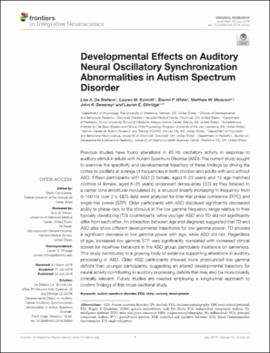| dc.contributor.author | De Stefano, Lisa A. | |
| dc.contributor.author | Schmitt, Lauren M. | |
| dc.contributor.author | White, Stormi P. | |
| dc.contributor.author | Mosconi, Matthew W. | |
| dc.contributor.author | Sweeney, John A. | |
| dc.contributor.author | Ethridge, Lauren E. | |
| dc.date.accessioned | 2019-09-26T20:16:32Z | |
| dc.date.available | 2019-09-26T20:16:32Z | |
| dc.date.issued | 2019-07-25 | |
| dc.identifier.citation | De Stefano, L.A., Schmitt, L.M., White, S.P., Mosconi, M.W., Sweeney, J.A. and Ethridge, L.E. (2019) Developmental Effects on Auditory Neural Oscillatory Synchronization Abnormalities in Autism Spectrum Disorder. Front. Integr. Neurosci. 13:34. doi: 10.3389/fnint.2019.00034 | en_US |
| dc.identifier.uri | https://hdl.handle.net/11244/321459 | |
| dc.description.abstract | Previous studies have found alterations in 40 Hz oscillatory activity in response to auditory stimuli in adults with Autism Spectrum Disorder (ASD). The current study sought to examine the specificity and developmental trajectory of these findings by driving the cortex to oscillate at a range of frequencies in both children and adults with and without ASD. Fifteen participants with ASD (3 female, aged 6–23 years) and 15 age-matched controls (4 female, aged 6–25 years) underwent dense-array EEG as they listened to a carrier tone amplitude-modulated by a sinusoid linearly increasing in frequency from 0–100 Hz over 2 s. EEG data were analyzed for inter-trial phase coherence (ITPC) and single-trial power (STP). Older participants with ASD displayed significantly decreased ability to phase-lock to the stimulus in the low gamma frequency range relative to their typically developing (TD) counterparts, while younger ASD and TD did not significantly differ from each other. An interaction between age and diagnosis suggested that TD and ASD also show different developmental trajectories for low gamma power; TD showed a significant decrease in low gamma power with age, while ASD did not. Regardless of age, increased low gamma STP was significantly correlated with increased clinical scores for repetitive behaviors in the ASD group, particularly insistence on sameness. This study contributes to a growing body of evidence supporting alterations in auditory processing in ASD. Older ASD participants showed more pronounced low gamma deficits than younger participants, suggesting an altered developmental trajectory for neural activity contributing to auditory processing deficits that may also be more broadly clinically relevant. Future studies are needed employing a longitudinal approach to confirm findings of this cross-sectional study. | en_US |
| dc.description.sponsorship | Open Access fees paid for in whole or in part by the University of Oklahoma Libraries | En |
| dc.language | en_US | en_US |
| dc.rights | Attribution 4.0 International | * |
| dc.rights.uri | https://creativecommons.org/licenses/by/4.0/ | * |
| dc.title | Developmental Effects on Auditory Neural Oscillatory Synchronization Abnormalities in Autism Spectrum Disorder | en_US |
| dc.type | Article | en_US |
| dc.description.peerreview | Yes | en_US |
| dc.identifier.doi | 10.3389/fnint.2019.00034 | en_US |
| ou.group | College of Arts and Sciences::Department of Psychology | en_US |

